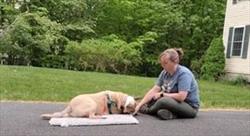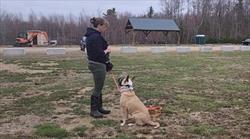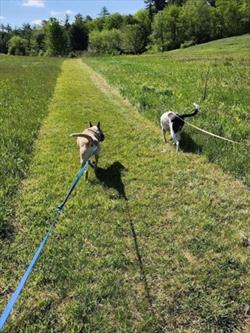Reactivity is an emotional response to a change in the environment that is based in fear, anxiety, or frustration. Dogs can explode or implode in their reactivity, which means they can lash out (external response) or shut down (internal response). Regardless of the type of response, it is important to recognize both as emotional.
When you have a reactive dog, it is easy to feel embarrassed, defeated, and frustrated. If you expect too much from your dog and place them in situations before they are ready, setbacks in the training process occur, and progress is not made. Breaking down the training and behavior modification steps into stages helps create a clear path forward and provides patterns of predictability, improving success rates.
These steps include:
1. Understanding
Knowing why your dog is struggling and what can realistically and practically be done to change how they feel and react is the first step. Understanding your dog’s body language will help you recognize when they are stressed. If you can figure out whether they are trying to escape, avoid, or approach the trigger, you will gain insight into their motivation and prevent a reaction from occurring. You can also use this method to identify what triggers your dog’s behavior.
2. Prevention & Environmental Management
Ensuring your dog feels safe should be a priority. Managing the environment by avoidance triggers keeps your dog from practicing this behavior and stops the progression. With repeat exposure, your dog will have an opportunity to practice the undesirable behavior, potentially becoming self-rewarding. Therefore, the behavior will be more likely to happen again in the future, with more intensity and less warning beforehand.
For example, think about your dog’s reaction to another dog on a walk. When on a leash, your dog might bark, growl, or lunge at another dog either at a close distance or far away. As your dog continues to react in this manner, the other dog moves away. What did your dog learn from this interaction? They learned their behavior was successful at scaring the other dog away, or they may be frustrated because they never had an opportunity to meet the other dog. Either way, they were given an opportunity to practice and fine-tune this behavior for the next encounter, so the reaction will take less time to occur and likely be more intense.
3. Build Foundation Behaviors at Home
Before you can start any type of behavior modification, your dog needs to learn certain foundation behaviors. Teaching your dog to touch your hand with their nose, chin rest, recall, and voluntary eye contact are all behaviors to build upon and use during the behavior modification process. Start by teaching your dog these behaviors in safe and low-distracting environments such as your living room, bedroom, or kitchen. Once they are learned in these locations, expand to other areas of the house and into your yard.
For example, if your reactive dog barks and lunges when they see other dogs while on a walk, think about what behavior you would rather see and how to keep your dog’s attention focused on you instead. These skills will be necessary if you hope to change your dog’s emotional response in this situation. Without foundation behaviors, your dog’s emotional brain is much more likely to override their thinking brain, which means the behavior will be hard to change.
4. Skill Building in Quiet Open Spaces
Once your dog learns critical foundation behaviors, then it is time to start practicing them away from home. Secure and quiet locations with an open space allow an opportunity to keep your dog a safe distance away from triggers while you practice. This type of environment gives your dog an opportunity to sniff and explore, which also helps to decrease stress and anxiety. Options such as open fields, abandoned or quiet parking lots, and yards or areas that can be rented (Sniff Spots) make great places to practice these new behaviors and work on your dog’s focus and engagement with you.
5. Controlled Distraction
Once your dog is responding to basic cues and you can keep their attention in a quiet, open space, plan an outing. Choose a controlled environment such as a parking lot or meet up with a friend and their dog (if your dog is friendly with theirs). Be sure to have a solid plan and exit strategy.
Use a “touch” cue to guide your dog as you practice turning around or moving away to avoid new people or dogs. As your dog becomes more comfortable and continues to engage with you, you can get closer to the triggers but avoid direct interaction.
Since you and your dog have practiced this behavior in less distracting environments, your dog should already know what to do. Keep these sessions short. If your dog becomes stressed, use your exit strategy and return to the previous step (quiet open spaces) in this process.
6. Practice in Real-World Settings
Once you get to this stage, it is time for your dog to experience the real world and all the uncertainty that comes with it. As your dog’s coping skills develop and their comfort level improves, you will still need a plan and exit strategy. However, if your dog continues to struggle, remember that some dogs may be more comfortable at home and shouldn’t be expected to interact or make friends with everyone. If this is the case, continue to enjoy your quiet walks, take sniff walks, and play games in the yard instead.







